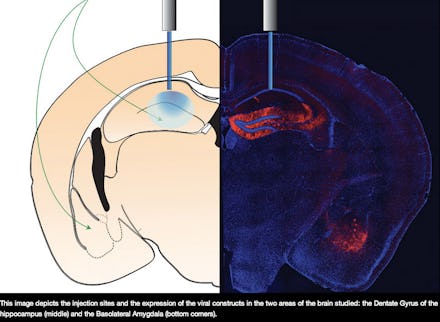MIT Scientists Are Halfway to Making 'Eternal Sunshine of the Spotless Mind' a Reality

The news: Forget the fiction of Total Recall, Inception and Eternal Sunshine of the Spotless Mind — this is reality.
Researchers at the Massachusetts Institute of Technology have just announced the discovery of the neural link between remembrance and emotional response, as well as an effective method of memory manipulation. The study, published Wednesday in the journal Nature, has huge implications for medicine, particularly in treating conditions such as depression and post-traumatic stress disorder.
"In the future, one may be able to develop methods that help people to remember positive memories more strongly than negative ones," Susumu Tonegawa, the senior author of the paper, said in a press release. "That plasticity of the connection between the hippocampus and the amygdala plays a crucial role in the switching of the valence of the memory."
How does it work? Valence is the emotional association tied to a specific memory. While a memory's context is stored in the hippocampus, the emotional components are filed away in the amygdala. Manipulating the link between these two parts of the brain plays a key part in influencing memory, but scientists have not been able to determine its exact location — until now.
Through an innovative technique called optogenetics, which uses light to control neuron activity, the MIT researchers were able to visually tag mice brain cells that were associated with certain memories. When those brain cells were reactivated with light, the mice behaved as though they were reliving those memories, or engrams, again.
For instance, male mice that disliked a certain location would suddenly prefer it when they were induced to remember being surrounded by female mice; mice that favored one location would then avoid it when their memory of being electrically shocked was reactivated.
By suppressing these memories, the researchers were able to retrain the mice and influence their behavior, leading the team to discover that valences were stored around the dentate gyrus.
This is science fiction turned into science. While there is a long way to go before these treatments can be adapted for human use, the MIT study represents a breakthrough in understanding memory and manipulation. Just last year, MIT researchers were able to plant or "incept" false memories in mice as well, bringing Christopher Nolan's mind-bending Hollywood blockbuster one step closer to reality.
"I see a world in which we can reactivate any kind of memory that we like. I also see a world where we can erase unwanted memories," Steve Ramirez, one of the researchers, said in a TED talk at the time. "I even see a world where editing memories is something of a reality because we're living in a time where it's possible to pluck questions from the tree of science fiction and to ground them in experimental reality."
It can be fun and intimidating to envision how these techniques can be applied to make treatments in movies such as Eternal Sunshine of the Spotless Mind come true. But while erasing the memory of a painful breakup might seem tempting, memory manipulation can serve a more vital function in treating mental health issues. By lessening the impact of traumatic memories, doctors could help patients move on and regain control of their lives.